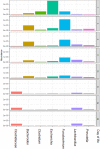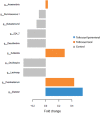Shifts in the Fecal Microbial Community of Cystoisospora suis Infected Piglets in Response to Toltrazuril
- PMID: 32508791
- PMCID: PMC7249887
- DOI: 10.3389/fmicb.2020.00983
Shifts in the Fecal Microbial Community of Cystoisospora suis Infected Piglets in Response to Toltrazuril
Abstract
The protozoan parasite Cystoisospora suis causes diarrhea and reduced weight gain in suckling piglets. Infections occur in the first days of life; it is transient but can lead to dysbiosis, exacerbating disease and increasing mortality. Cystoisosporosis is effectively controlled by toltrazuril treatment; however, alterations of the gut microbial composition upon infection and treatment have not been investigated. This study evaluated the development of fecal microbiota of C. suis infected piglets in response to treatment with toltrazuril. Thirty-eight conventional piglets were infected with C. suis on the first day of life (dol 1). Twenty-six of them received either parenteral or oral toltrazuril 2 days later. Fecal samples were collected pre- and post-weaning (dol 1-15 and 31-38) for microbiota analysis using 16S rRNA amplicon sequencing and during dol 5-18 to determine fecal consistency and parasite excretion. All control animals shed parasites at least once and the majority developed diarrhea, while toltrazuril-treated piglets did not excrete parasites and only had low levels of diarrhea. Age-related shifts in the fecal microbiota composition and increase in diversity and species richness were seen until after weaning. Parasite infection disrupted bacterial maturation 2 weeks after infection. Irrespective of the route of administration, fecal communities of piglets in the treated groups clustered separately and were more diverse compared to that of control piglets during the acute phase of infection on dol 11. Control piglet feces showed higher levels of Fusobacteriaceae and Veillonellaceae, while Ruminococcaceae, Lachnospiraceae, S24-7, Clostridiaceae, and Erysipelotrichaceae were more abundant in feces of treated piglets on dol 11. Thereafter, treatment-related effects on the microbial communities were small and mainly detectable on dol 34 (5 days post-weaning), potentially indicating that the oral toltrazuril treatment might have had long-term effects on host physiological responses post-weaning. Irrespective of the administration route, toltrazuril prevented C. suis-related dysbiosis and maintained species richness and diversity on dol 11. In addition to cystoisosporosis prevention, toltrazuril seems to contribute to the stabilization of the gut microbial development during the suckling phase and thus may reduce the need for antibiotics to control infections with secondary bacterial enteropathogens in C. suis-infected suckling piglets.
Keywords: 16S rRNA; diarrhea; gut health; microbiota; piglet.
Copyright © 2020 Shrestha, Metzler-Zebeli, Karembe, Sperling, Koger and Joachim.
Figures





References
-
- Almeria S., Cinar H. N., Dubey J. P. (2020). “Coccidiosis in humans,” in Coccidiosis in Livestock, Poultry, Companion Animals, and Humans, ed. Dubey J. P. (Boca Raton: CRC Press; ), 267–312.
-
- Barta J. R., Schrenzel M. D., Carreno R., Rideout B. A. (2005). The genus Atoxoplasma (Garnham 1950) as a junior objective synonym of the genus Isospora (Schneider 1881) species infecting birds and resurrection of Cystoisospora (Frenkel 1977) as the correct genus for Isospora species infecting mammals. J. Parasitol. 91 726–727. 10.1645/GE-3341.1 - DOI - PubMed
LinkOut - more resources
Full Text Sources

